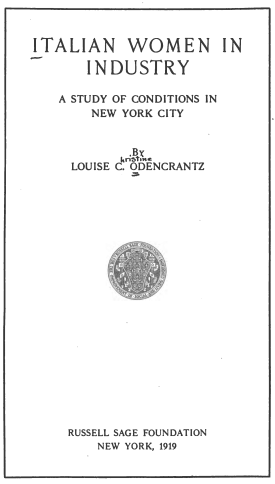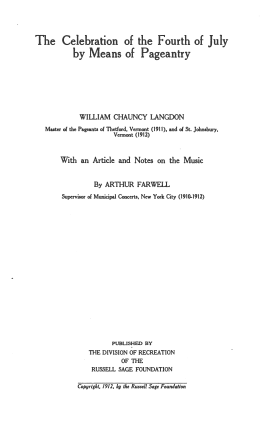About This Book
A pamphlet promoting the after-class use of school buildings for recreational, social, and civic community activities.
CLARENCE ARTHUR PERRY, Department of Child Hygiene, Russell Sage Foundation
A pamphlet promoting the after-class use of school buildings for recreational, social, and civic community activities.
CLARENCE ARTHUR PERRY, Department of Child Hygiene, Russell Sage Foundation
A report on the community center sessions at the N.E.A. Department of Superintendence meeting, Cleveland, February 1920 Published by the Department of Recreation of the Russell Sage Foundation.
CLARENCE ARTHUR PERRY, Department of Recreation, Russell Sage Foundation

Published in 1919, Italian Women in Industry presents the findings of a study of Italian working women in New York City in the early twentieth century, touching upon the problems of both immigration and industry.
LOUISE C. ODENCRANTZ, Department of Surveys and Exhibits, Russell Sage Foundation

All the reports presented at the fifty-first Annual Congress of the American Prison Association in 1921. The subjects of the papers are wide in scope, many relating not only to the administration of prisons and the treatment of prisoners, but to probation, parole, mental health, juvenile delinquency, and other related subjects.
C. B. ADAMS was president of the American Prison Association.

Published by the Division of Recreation of the Russell Sage Foundation, this pamphlet presents a number of suggestions for a safe celebration of the Fourth of July. It includes notes on Independence Day music considerations by Arthur Farwell, then supervisor of municipal concerts for New York City.
WILLIAM CHAUNCY LANGDON was Master of the Pageants of Thetford, Vermont (1911), and of St. Johnsbury, Vermont (1912).
A volume of the Pittsburgh Survey, carried out by the Russell Sage Foundation in 1914.
PAUL UNDERWOOD KELLOGG was director of the Pittsburgh Survey.
A volume of the Pittsburgh Survey carried out by the Russell Sage Foundation in 1914, focusing on Pittsburgh's history and growth, civic conditions, and education, recreation, and institutional facilities.
PAUL UNDERWOOD KELLOGG was director of the Pittsburgh Survey.

A volume of the Springfield Survey published in 1914, this report presents a clear idea of the housing conditions in Springfield at the time, as well as the methods taken to keep conditions up to standard. Topics include land overcrowding, unhealthy circumstances in apartments, and housing for miners, with an argument of what the city could do to improve conditions.
JOHN IHLDER, Springfield Survey Committee
Presented at the fifty-first congress of the American Prison Association in 1921, this pamphlet attempts to develop proper, universal plans for a model jail. Arguing that each prison would have specific building requirements and characteristics, the author presents several well-established canons of architecture and building which should be followed in any jail, emphasizing humane conditions and required needs. Printed with A Departmental Plan for a Detention Home for Delinquent Women by Maxwell Hyde.
R. W. ZIMMERMAN, prison architect, Chicago

This is a pamphlet of two reports on munition work during World War I, the second is by Henriette R. Walter, entitled Munition Workers in England and France: A Summary of Reports Issued by the British Ministry of Munitions.
AMY HEWES was professor of economics and sociology at Mount Holyoke College.